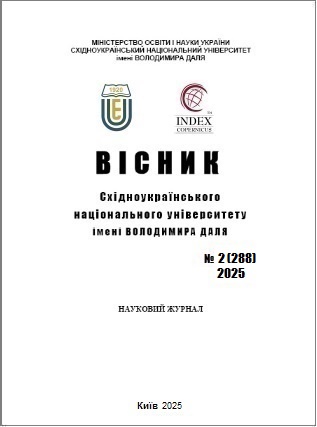Моделювання роботи газорідинного сепаратора
DOI:
https://doi.org/10.33216/1998-7927-2025-288-2-24-31Ключові слова:
газорідинний сепаратор, сепарація сумішей, газорідинний потік, краплинна рідина, очищення газу, імітаційне моделювання, масова концентраціяАнотація
У статті виконано комплексне дослідження конструкцій та принципів дії газорідинних сепараторів, які широко використовуються в промисловості для очищення газових потоків від краплинної рідини та твердих домішок. Актуальність роботи зумовлена необхідністю підвищення ефективності розділення фаз, мінімізації втрат енергії, зменшення габаритів та витрат на експлуатацію обладнання. Автори провели огляд сучасних технологій сепарації, проаналізували конструктивні особливості газорідинних сепараторів та методи оптимізації їхньої роботи. Основну увагу зосереджено на використанні програм CFD для імітаційного моделювання процесів у газорідинному сепараторі. Для дослідження вибрано та побудовано тривимірну модель сепаратора, у якій визначено розподіли тиску, температури та масової концентрації компонентів у газовому потоці. Під час моделювання враховано різні умови експлуатації, такі як зміна температури, тиску та об’ємної витрати. Також враховано багатокомпонентність газового потоку. О’ємна концентрація компонентів газової суміші: метан – 93 %, водень – 0,1 %, етан – 2,5 %, пропан – 0,31 %, бутан – 0,11 %, метанол – 0,08 %. Особливу увагу приділено впливу конструктивних елементів сепаратора на ефективність розділення фаз. Встановлено, що із зменшенням температури газорідинного потоку зменшується ефективність роботи сепаратора. Побудовано графічну залежність масової концентрації води у вихідному газовому потоці від витрати та температури газорідиної суміші. Досліджено вплив підігріву корпусу сепаратора на ефективність його роботи. Застосування підігріву корпусу сепаратора дозволяє значно знизити масову концентрацію краплинної рідини у вихідному газовому потоці. Отримані результати можуть бути використані для модернізації існуючих газорідинних сепараторів, а також при розробці нових високоефективних конструкцій. Практичне значення роботи полягає у зменшенні енергозатрат та підвищенні надійності роботи обладнання в різних галузях промисловості, таких як нафтогазова, хімічна та енергетична. Для забезпечення оптимальних витрат на відокремлення з газового потоку води в подальшому планується виконати оптимізаційне параметричне дослідження.
Посилання
1. Михайлюк В. В., Фафлей О. Я., Мельник В. О., Захара І. Я., Малишев А. Р., & Процюк Г. Я. Моделювання газового вертикального сіткового сепаратора. Науковий вісник Івано-Франківського національного технічного університету нафти і газу. 2022. №1(52), 91–100. https://doi.org/10.31471/1993-9965-2022-1(52)-91-100
2. L. M. Mil’shtein, Modernization of Oil and Gas Field Separation. Development of New-Generation Separation Units and Apparatuses, LAP Press, Saarbrücken, Germany (2012).
3. Liu C S Development and field test of separator in prying loading type gas collecting device. Natural Gas and Petroleum. 1994. 12 36-40
4. Vijayan, V., Vivekanandan, M., Venkatesh, R. et al. CFD modeling and analysis of a two-phase vapor separator. J Therm Anal Calorim 145, 2719–2726 (2021). https://doi.org/10.1007/s10973-020-09825-2
5. Kou J, Li Z. Numerical Simulation of New Axial Flow Gas-Liquid Separator. Processes. 2022; 10(1):64. https://doi.org/10.3390/pr10010064
6. Liakh M.M., Yuriev E.V., Vakaliuk V.M., Solonychnyi Ya.V. Matematychna model separatsii hazoridynnoi sumishi v separatori inertsiinoho typu. Rozvidka ta rozrobka naftovykh i hazovykh rodovyshch. 2008. № 1. P. 67-73.
7. Ye, Junxiang & Xu, Yanxia & Song, Xingfu & Yu, Jianguo. Novel conical section design for ultra-fine particles classification by a hydrocyclone. Chemical Engineering Research and Design. 2019. 144. 10.1016/j.cherd.2019.02.006.
8. Zhang, Caie & Wei, Dezhou & Cui, Baoyu & Li, Tianshu & Luo, Na. Effects of curvature radius on separation behaviors of the hydrocyclone with a tangent-circle inlet. Powder Technology. 2017. 305. 10.1016/j.powtec.2016.10.002.
9. Emam, Mahmoud & Zhou, Ling & Shi, Weidong & Chen, Han. Performance evaluation of standard cyclone separators by using CFD–DEM simulation with realistic bio-particulate matter. Powder Technology. 2021. 385. 10.1016/j.powtec.2021.03.006.
10. Wiencke B 2011. Fundamental principles for sizing and design of gravity separators for industrial refrigeration. International Journal of Refrigeration. 34 2092-2108.
11. Chu, Kaiwei & Wang, B. & Xu, D.L. & Chen, Y.X. & Yu, Aibing. CFD–DEM simulation of the gas–solid flow in a cyclone separator. Chemical Engineering Science. 2011. 66. 834-847. 10.1016/j.ces.2010.11.026.
12. Katare, Pravin & Krupan, Abhineel & Dewasthale, A. & Datar, A. & Dalkilic, A.S.. CFD analysis of cyclone separator used for fine filtration in separation industry. Case Studies in Thermal Engineering. 2021. 28. 101384. 10.1016/j.csite.2021.101384.
13. Chu, Kaiwei & Wang, B. & Xu, D.L. & Chen, Y.X. & Yu, Aibing. CFD–DEM simulation of the gas–solid flow in a cyclone separator. Chemical Engineering Science. 2011. 66. 834-847. 10.1016/j.ces.2010.11.026.
14. Vytyaz, Oleg & Chudyk, I. & Mykhailiuk, V.. Study of the effects of drilling string eccentricity in the borehole on the quality of its cleaning. 2015.
15. N. D. Katopodes, Free-Surface Flow: Computational Methods, Oxford, UK: Butterworth-Heinemann, 2019
16. V. Dragan, I. Malael, and B. Gherman, "A Comparative Analysis Between Optimized and Baseline High Pressure Compressor Stages Using Tridimensional Computational Fluid Dynamics," Engineering, Technology & Applied Science Research, vol. 6, no. 4, pp. 1103–1108, Aug. 2016, https://doi.org/10.48084/etasr.696.
17. Maistruk V.V. Otsinka enerhozatrat pry roboti priamotechiinoho tsyklonu za dopomohoiu prohramnoho paketu FLOW SIMULATION / V.V. Maistruk, R.I. Havryliv, A.S. Popil, A.M. Basistyi // Vostochno-Evropeyskiy zhurnal peredovyih tehnologiy. Kharkiv. 2012. Vyp. 6/8(60). P. 28-30.
18. F. P. Lucas and R. Huebner, "Numerical Simulation of Single-Phase and Two-Phase Flows in Separator Vessels with Inclined Half-Pipe Inlet Device Applied in Reciprocating Compressors," Engineering, Technology & Applied Science Research, vol. 8, no. 3, pp. 2897–2900, Jun. 2018, https://doi.org/10.48084/etasr.1993.
19. S. C. K. De Schepper, G. J. Heynderickx, and G. B. Marin, "CFD modeling of all gas–liquid and vapor–liquid flow regimes predicted by the Baker chart," Chemical Engineering Journal, vol. 138, no. 1, pp. 349–357, May 2008, https://doi.org/10.1016/j.cej.2007.06.007.
20. A. P. Laleh, W. Y. Svrcek, and W. D. Monnery, "Design and CFD studies of multiphase separators - a review," The Canadian Journal of Chemical Engineering, vol. 90, no. 6, pp. 1547–1561, 2012, https://doi.org/10.1002/cjce.20665.
21. G. Cheng, L. Y. Yan, and H. Zhou, "The Oil Vessel Structure Optimization by the use of CFD in the Oil Injection Twin-Screw Compressor," presented at the International Compressor Engineering Conference, West Lafayette, IN, USA, 2004, Art. no. 1714.
22. Xu, Yanxia & Ye, Junxiang & Song, Xingfu & Yu, Jianguo. Classification of Ultrafine Particles Using a Novel 3D-Printed Hydrocyclone with an Arc Inlet: Experiment and CFD Modeling. ACS Omega. 2022. 8. 10.1021/acsomega.2c06383.
23. Tian, J. Y.; Ni, L.; Song, T.; Zhao, J. N. CFD simulation of hydrocyclone−separation performance influenced by reflux device and different vortex−finder lengths. Sep. Purif. Technol. 2020, 233, No. 116013. DOI: 10.1016/j.seppur.2019.116013

